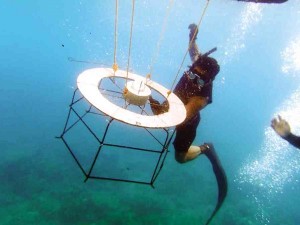Helping coral reefs with beads of faith

A SCUBA diver helps put in place the coral rosary in the waters off Barangays San Vicente and Pandayan in Sto. Domingo, Albay. MARTIN REYNOSO/CONTRIBUTOR
In what could be the first of its kind in the world, a 65-meter-long artificial reef shaped like a rosary was dropped into the Albay Gulf off the coastal town of Sto. Domingo in Albay.
The structure symbolizes the “Our Lady of the Most Holy Rosary,” patroness of Sto. Domingo parish, said Martin Reynoso, executive vice president of the Junior Chamber International (JCI)-Legazpi and project officer of the Coral Genesis project initiated by the JCI.
Mayor Herbie Aguas said the project manifested the people’s commitment to environmental protection and was expected to draw more tourists, particularly divers and snorkeling enthusiasts, into his town, which is known for its scenic long stretch of black-sand beaches.
Mysteries
Article continues after this advertisement
At least 20 scuba divers put in place the rosary reef in a 20-foot deep site in the waters off Barangays San Vicente and Pandayan, about a kilometer from the town proper, on Aug. 3. The divers belong to Bicol Scuba Divers Foundation, Philippine Navy, Philippine Coast Guard and JCI.
Article continues after this advertisementIt took them five hours to lay the 60 coral beads and a five-meter cross over a 300-square-meter area in the sea bottom, Reynoso said. The beads represented the mysteries of the Holy Rosary—Joyful, Sorrowful, Glorious and the Mysteries of Light.

MICRO solar panels are implanted on the concrete structure at the sea bottom. MARTIN REYNOSO/CONTRIBUTOR
Reynoso said a test survey conducted in the waters off Sto. Domingo found the area “not so shallow, not so deep and still clean,” making it a perfect site for the coral rosary.
It was also observed that only patches of corals were present and signs of coral bleaching, which is sometimes caused by the warmer than normal temperature of the water. According to Reynoso, the coral reef condition was not that bad, but “it needs help.”
With the coral rosary, Reynoso said members of the Bantay Dagat would have something “concrete” to protect as the solar-powered artificial reefs would enhance coral growth, thus making it a breeding site for fishes.
Solar panels
The coral beads were “implanted with 65 micro solar panels at the concrete structure, wires, lead conductor and glass jar,” Reynoso said.
The technology, which uses a portable micro underwater solar power source, is a coral-reef electrification concept aimed to help corals grow five times faster and make them resistant to coral bleaching and algae, he explained.
It allows any shape, design, logo, or sculpture to be charged for fast coral-reef recovery or even creation of thematic sculptures, Reynoso said.
Procession
The electrically propagated coral would begin to work when the wires reeled into the concrete beads are negatively charged and start attracting calcium particles that would then build up on the surface and form artificial reefs and also serve as the base for the coral nodules to attach to the reef.
Before the coral launch, a procession of the image of Our Lady of the Most Holy Rosary was held, joined by hundreds of people led by “healing priest” Momoy Borromeo, Albay Gov. Joey Salceda and Mayor Aguas.
Aguas said his administration also planned to develop an 8-square-kilometer fish sanctuary in the villages of San Vicente, Pandayan, Sto. Domingo, Del Rosario and San Juan.
Salceda said the coral reef project complemented Capitol’s rapid marine assessment survey to check the status of corals in the province and consequently come up and implement measures to restore and protect coral reefs in Albay Gulf.
He pledged a P1-million fund to finance the organization of fishing families into a cooperative in Sto. Domingo.
The coral reef propagation and restoration is part of the tourism development program under the Cagraray, Rapu-Rapu, Batan and San Miguel (CRABS) area of the provincial government.
Reynoso said the JCI project would hopefully generate more income as the area could become an ecotourism—and a pilgrimage—destination.